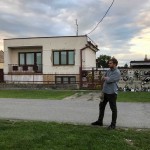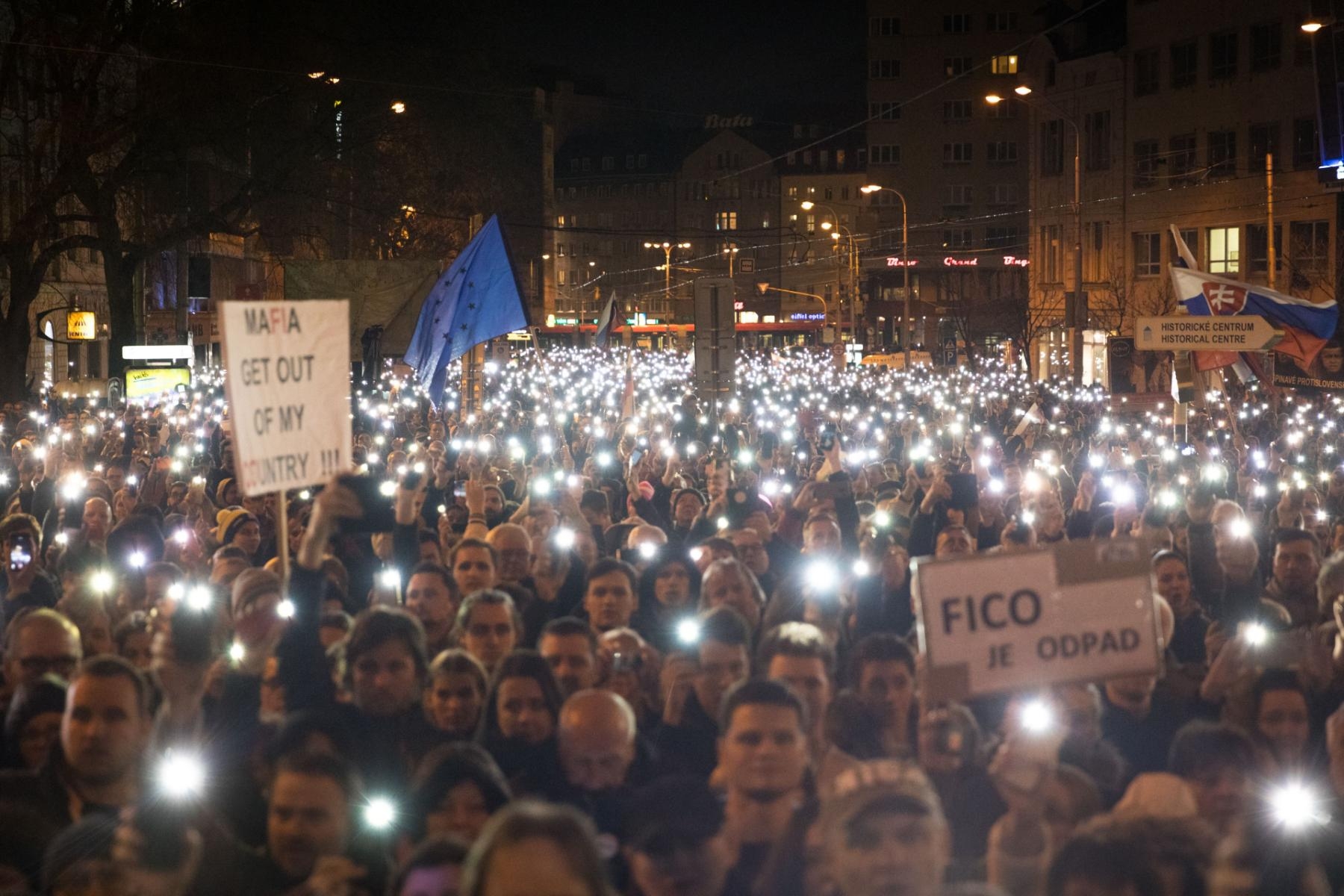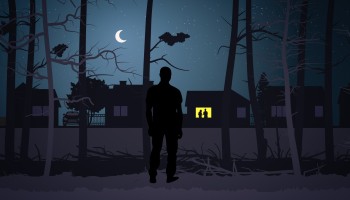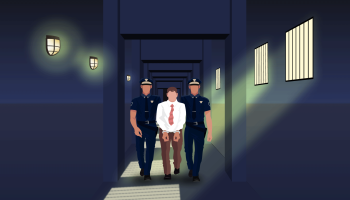For years, Marian Kočner was one of the most wealthy and powerful businessmen in Slovakia, a man whose connections with judges and prosecutors made him virtually untouchable, and whose extravagance made him a frequent fixture in local tabloids. Today, the middle-aged businessman’s craggy face and prominent shock of black hair are mostly seen in dispatches from the courtroom he sits in day after day.
Kočner is the main defendant in a high-profile trial that has gripped the country since December. He is charged with ordering the brutal murder of a young investigative journalist who had been reporting on corrupt Slovak politicians, Italian mafiosi — and Kočner himself.
The journalist, 27-year-old Ján Kuciak, was shot in his home along with his fiancee, Martina Kušnírová, by an armed assailant who has since confessed to the killing. The shocking double murder made headlines round the globe in February 2018. In Slovakia, it drove tens of thousands into the streets in cities across the country to demand an independent investigation.
As the official inquiry began to seem increasingly inadequate, riddled with apparent misdirections and even outright deception, demands for change grew. Many Slovakians called for new leaders who would do the young man justice. In due course they had them. First the interior minister, then the prime minister, and finally a widely criticized police chief resigned one after the other.
By September 2018, the once moribund investigation showed new signs of life. Four co-conspirators, including the murderer himself, were taken into custody. Prosecutors soon charged Kočner, now 56, with organizing the killing, and he was formally indicted along with the others in October 2019.
Nearly a hundred journalists from around the world have registered to cover his trial, and the latest developments are regularly broadcast on Slovakia’s main television channels. One-time allies now disavow the well-connected businessman. Kočner’s own brother told a reporter that he was considering changing his name, should Kočner be found guilty.
But the trial is shedding light on more than the murder of a journalist. A massive trove of data collected by police during the investigation, including files from Kočner’s phones and personal computer, has been made available to OCCRP journalists. The data not only reveals that Kuciak and his fiancée were murdered in cold blood for 50,000 euros, but also shows how Kočner has kept himself above the law by oiling the justice system of Slovakia’s fragile young democracy with cash and kompromat.
For over 20 years, the controversial businessman was widely suspected of multiple financial crimes, including VAT fraud, forging promissory notes, and even taking over a popular independent TV station. Though police opened investigations into some of these cases, and the evidence of his crimes was publicly available and overwhelming, Kočner was never successfully prosecuted.
The data obtained by reporters shows how he got away with it for so long: Blackmail, corruption, and personal connections with pliant prosecutors, judges, and well-placed insiders. His success paints an unflattering picture of the justice system in a country that has often been touted as a poster child for successful transition from communist rule to European rule of law.
A Kočner lawyer did not comment for this story, questioning reporters’ credentials. Another said he no longer represented the businessman, and a third could not be reached for comment.
“The Belly”
Marian Kočner grew up in the small northern Slovakian town of Ružomberok. Ironically, he began his career as a journalist, graduating from Bratislava’s Comenius University and working as a television reporter for a state broadcaster.
But his media career wouldn’t last. With the crumbling of communism in Central Europe in the late ’80s, Slovakia began a painful transition away from a centralized economy that had been in place since 1948. As in the other former Eastern Bloc states, the country’s society and political system struggled to adapt.
Crime began to rise as a fragile new legal regime, staffed with inexperienced prosecutors and judges, found itself unable to cope. In the new private sector, there were opportunities to make money in both scrupulous and unscrupulous ways.
It was in this context that Kočner first entered the public eye in the late ‘90s, no longer as a journalist but as a businessman. Though initially known only as a side player in a major financial fraud, the so-called “Technopol case,” the scandals in which he was allegedly involved continued to mount over the following decades, making him a notorious figure (see boxes).
The Kočner Cases
Over the same period, Kočner also began to appear in Slovakian celebrity magazines, where he was portrayed as a vain businessman who enjoyed flaunting his wealth. He was depicted driving a white Bentley around Bratislava, parking in spaces for the disabled as a display of his untouchability, and showering powerful officials with luxury handbags, watches, and other expensive gifts. The tabloids also reported that Kočner, whose nickname was “The Belly,” had gastric bypass surgery to lose weight.
Much more serious were the measures Kočner appears to have taken to ensure he would never face serious scrutiny for his alleged crimes.
“All The Money Ended Up With Me”
In 2004, Dobroslav Trnka, then a deputy prosecutor general, was elected by parliament to the position of prosecutor general, giving him wide latitude to set the direction and scope of criminal investigations in the country.
The newly obtained police data makes it clear that Trnka — whom Kočner referred to familiarly as “Dobroš” — was a close ally of the controversial businessman.
In a recorded telephone conversation, Kočner reiterates to Trnka that he had Kočner to thank for at least some of the parliamentary votes in his favor during his 2011 reelection attempt, when he fell just one vote short.
In the 70-minute-long recording, the businessman upbraids the former prosecutor general for allegedly making a copy of a secret police file known as the “Gorilla Case” (see box) and using it to blackmail a businessman involved.
The Gorilla Case
Kočner and Trnka’s discussion, which took place in 2014, centers on a major corruption scandal that had erupted a few years earlier after a secret police file, purportedly based on wiretaps made in a Bratislava apartment, appeared on the internet. The affair became known as the “Gorilla Case” after the police code name for the operation.
“Why did you go and blackmail Haščák [a businessman who figures in the Gorilla Case]?” Kočner demands to know. “You fucking know he’s my friend. Fuck, do you know he is a man who, apart from other things, helped to fucking bribe the MPs when you were about to be [reelected as] prosecutor general?”
“Unfortunately we were one [vote] short,” Kočner continues. “But he was the one who deposited money and gave a million euros on your behalf. Exactly the same way I gave a million myself. The fact that we were one vote short, fuck, is not my fault.”
Trnka protests that he had not made a copy of the file and had not used it to blackmail anyone.
In response, Kočner continues to berate Trnka, demanding that he tell the truth about the audio and threatening him with retribution: “Only the truth will save you, and perhaps your son,” he says. “Because if you screw up … you’ll go to jail, and your son’s life will be ruined. … If you deceive me, you’ll see what I’ll do with you.”
“It will cost you, you will see what at the end,” Kočner says ominously.
In response, Trnka meekly acknowledges that the businessman had threatened his life: “Well, a bullet. Thirty-two [Slovak] crowns,” he replies. He had gotten the point.
In the same conversation, Kočner mentions funds he kept on Trnka’s behalf. Judging from their conversation, in which they mention the names of two Kočner allies, at least one of whom had an ongoing criminal case, the money may have been intended to buy legal favors.
“No, you never took anything,” Kočner says. “All the money that ended up with me. You never wanted to know how much and for what, and you said that I should hold it. You never asked how much you got there, you always came and said you needed this and that, and I always withdrew [the money] and gave it to you. Is that so?”
“It is,” Trnka replies.
In addition to this audio recording, the newly obtained data contains a video that shows Kočner personally installing a hidden camera in Trnka’s office to record confidential conversations.

In one such undated recording discovered in Kočner’s files, Trnka and Ján Počiatek, then Slovakia’s finance minister, are heard having a sensitive conversation about an ongoing scandal in which Počiatek had approved a controversial payment to settle an intellectual property rights case involving a state firm. Kočner’s possession of this potentially embarrassing recording demonstrates the power he wielded over the prosecutor general.

During the seven years Trnka remained in the post, Kočner was never indicted for any reason, though his involvement in an array of dubious and possibly illegal schemes was subsequently reported using publicly available information.
On one occasion, several prosecutors tried to investigate the businessman for his involvement in a financial fraud known as the Glance House case — only to have their efforts overturned by Trnka. After the prosecutor general was narrowly voted out in 2011, he remained in the office in another position and retained much of his influence.
Trnka could not be reached for comment.
“Grant or Dismiss? 🤔”
Trnka wasn’t the only official in Slovakia’s judicial system who did Kočner’s bidding.
Data obtained from Kočner's phones show his influence over a group of several judges at important courts — often the very same courts in which cases involving Kočner were being decided.
It is not clear what kind of leverage Kočner may have had over these judges. But the content of his discussions with some of them on WhatsApp and Threema, another chat service, make the value of these relationships clear.
In one case, he tells Vladimír Sklenka, then the vice president of Bratislava’s First District Court, that he should “come and pick up his Christmas [present].” Later, he tells Sklenka that “the amount 40 has been deposited,” and on another occasion asks the judge whether he has gotten used to his new phone.
On the other side, Sklenka’s position enabled him to review materials related to the second Technopol case — an ongoing suit in which Kočner was involved — and to provide the businessman with step-by-step insights about what his opponents were doing.
On another occasion, Sklenka openly asked Kočner how he should rule in an ongoing case: “And how now? [Should I] grant or dismiss? 🤔”
Monika Jankovská, a judge and deputy justice minister, was similarly high-placed — and similarly intertwined with Kočner. Over the course of eight months, she exchanged over 6,200 messages with him, communicating about his payments to her and other judges for court rulings, discussing ongoing cases, and exchanging kissing emojis.
“I suppose you’re going to split Zuza’s reward also with Denisa [Cviková],” Kočner writes to Jankovská, referring to judges involved in the second Markiza case.
“No, Deni will get part of mine. I promised that cunt something and now I must keep it,” Jankovská replies.
Since Jankovská was highly placed in the Justice Ministry, she was able to use her influence to press the judge in charge of the case, Zuzana Maruniaková (or “Zuza”), to issue a decision favorable to Kočner. Maruniaková did so.
Sklenka resigned in December after his communications with Kočner were made public. Jankovská also resigned from the Ministry of Justice and was later suspended from her position as a judge.
Sklenka could not be reached for comment for this story. Cviková and Maruniaková also could not be reached, and a spokesperson for the Bratislava District Court said they were not available for comment. Jankovská hung up the phone when contacted by reporters.
Police Ties
Kočner’s influence wasn’t limited to top prosecutors and judges.
During the Kuciak murder trial, one of the co-conspirators, Zoltán Andruskó, testified that he had been afraid to report the journalist’s planned murder to police because of Kočner’s extensive connections. Though Andruskó may have been seeking to exculpate himself, there are grounds to believe that Kočner’s influence was real.
One of the businessman’s most powerful friends was Norbert Bödör, a mixed martial arts coach and son of the head of a well-connected private security company. That company, Bonul, made a fortune on public tenders thanks to its close connections with Slovakia’s ruling SMER-SD party. The party’s leader, ex-Prime Minister Robert Fico, was known to attend Bonul’s Christmas parties while in office.
Reporters obtained thousands of messages Kočner and Bödör exchanged in 2017 and 2018. The two men texted each other at least several times a week, discussing sensitive matters such as ongoing police investigations.
Moreover, among the tasks Kočner assigned to Bödör was obtaining personal information about his enemies, including journalists, from police databases.
“Can you please pull the spider [web]?” he asked, referring to a compilation of personal information about his targets, including home addresses, names of children and other family members, and car license plates.
Data obtained from one of Kočner’s USB drives confirms that he eventually received the information he had asked for. The data also shows that Kuciak was among the journalists Kočner was investigating.
The well-connected Bödör would have been in a good position to get Kočner what he needed. He is related to Tibor Gašpar, then the head of the Slovak Police Force, by marriage, and the two families are known to be close. What’s more, a police officer who had been logged accessing the data about Kuciak told investigators that he had done so at Gašpar’s request.
In response to questions, Bödör referred reporters to an earlier interview with SME, a Slovakian daily publication. In that interview, he confirmed that he knew Kočner personally, denied helping him surveil journalists, and expressed disbelief that he could have ordered the double murder. He also confirmed his family relation to Gašpar.
When reached for comment, Gašpar referred reporters to his Facebook page, where no answers had been posted at the time of publication.
The Honey Trap
Kočner’s techniques for maintaining his influence went beyond bribery. One of his most essential allies was his lover, Alena Zsuzsová. Over a period of several years, she obtained compromising information about high-level politicians, prosecutors, and lawyers for Kočner’s benefit.
Data obtained from one of Kočner’s phones shows that Zsuzsová initiated flirtatious Facebook conversations with people of interest to the businessman.
When they responded, Zsuzsová took the conversations to more private channels such as WhatsApp. Her mode of operation was to send her targets photographs of models with her face photoshopped onto their partially clad bodies, and to request images in return. A number of her victims complied, sending photos that confirmed their positions — such as the deputy speaker of parliament sending a picture with the parliamentary insignia — or even photos of their genitalia. She passed the photos to Kočner, sometimes accompanied by derogatory statements.
“Next willy for your collection,” she texted. “Are you really really sure you want to see it? I need to warn you. I have never seen anything as ugly and disgusting in my life as this one. It made me sick when I saw it….”
In some cases, she made recordings of phone conversations with her targets and sent these to Kočner as well. The information she obtained in this manner included internal information about the functioning of the office of one prosecutor, a married man who, in one recorded conversation, tells her so much that she can hardly get a word in edgewise.
In their own private conversations, Zsuzsová and Kočner refer to their victims as “sheep,” classifying them in groups according to their level of influence. More influential targets would net Zsuzsová higher payments.
“A class-one [sheep] is 30,000 euros and a class-two [sheep] is 10,000,” Zsuzsová confirmed for Kočner’s approval.
A Young Journalist
Unbeknownst to Kočner, the same Gorilla Case he had discussed with his obedient prosecutor general would set in motion the chain of events that led to his downfall.
When news of the scandal first broke in 2011, the file containing the transcripts of the secret wiretaps became a sensation in the Slovakian media. But perhaps the most devoted reader of the 69-page document was Ján Kuciak, then still a journalism student in Nitra, a small city in western Slovakia.
Instead of working on his bachelor thesis, the young man, then just 21, became obsessed with the affair. He spent hours reading and analyzing the material, doing his best to confirm the details from public sources and publishing his findings. It was this experience that first made him realize how passionate he was about investigative journalism.
Kuciak’s aptitude for the work was quickly recognized by his colleagues. By the fall of 2015, he was invited to join the investigative team of a fledgling Slovakian news website, Aktuality.
The junior investigative reporter soon began to focus on Kočner. In the spring of 2017, he started publishing a series of articles about the businessman’s questionable dealings.
Kuciak’s reporting also raised troubling questions about the failed or closed police investigations into Kočner, and exposed blatant mistakes on the part of police investigators and prosecutors.
More damning still was the fact that, in his reporting, Kuciak relied on public sources, such as the Slovakian business registry, which should have been readily available to law enforcement officials. Some of the alleged crimes he described were carried out during Trnka’s tenure as Slovakia’s top prosecutor.
In the first open confrontation between the reporter and the businessman, Kuciak asked Kočner several technical questions about his businesses at a June 2017 press conference. In response, Kočner lost his temper, telling Kuciak his reporting was “not true” and calling him a liar.
His frustration was perhaps unsurprising. Just a month later, in the wake of growing public pressure spurred by Kuciak’s reporting, a special prosecutor reopened a shuttered investigation into the Donovaly case.
In an ominous sign, Kočner called the young reporter that September and accused him of targeting his family and of writing about him on someone’s orders. Kuciak calmly denied both accusations, but received only threats in response.
“I will start paying special attention to you and your person, your mother, your father and your siblings,” Kočner says. “I guarantee you will stop writing.”
According to his friends, Kuciak was not overly concerned about Kočner’s threat, considering such episodes simply a part of the job. He continued his reporting, publishing further investigations about Kočner in the following months.
Unknown to the young reporter, Kočner was already planning his murder. According to the indictment, it was Zsuzsová, the businessman’s ever-reliable partner, who he asked to organize the hit.
On February 21, 2018, two hit men arrived in Velká Mača, a small village 60 kilometers from Bratislava where Kuciak and his fiancée were renovating a small house. It took three bullets to snuff out both 27-year-olds’ lives. But the story wouldn’t end there — not for Slovakia and not for Kočner.
Kočner’s Downfall
The Slovakia of 2018 was no longer the wild country it was in the ’90s, when the president’s son could be kidnapped by the state’s own security services. It had been a full-fledged member of the European Union for over a decade, and the murder of a young journalist in retaliation for his work simply wasn’t supposed to happen.
The public reacted within days. Though only a small memorial march was expected on the Friday after the murders, up to 25,000 people flooded the streets of Bratislava. The energy of the march felt not just elegiac, but political.
Since Kuciak had been investigating the infiltration into Slovakia of the dreaded Italian ’Ndrangheta mafia — and its collusion with government officials — many protesters associated his murder with government corruption. They held signs inspired by his work: “Mafia get out of my country,” and “Fico is in bed with the Italian Mafia.” Above all, the public demanded an independent police investigation into the case.
Over the following months, young Slovaks all over the country, in cities large and small, started organizing weekly Friday protests to demand “a decent Slovakia.”
Initially, however, their demand for an impartial investigation remained unmet. Government officials and Tibor Gašpar, the chief of police, produced numerous and puzzling theories about the murders. These included suggestions that the killings had been the work of drug addicts, that they had been motivated by romantic jealousy, and even that Martina, and not Ján, had been the real target.
An Unexplained Presence at the Scene of the Crime
One occurance attracted more outrage during the investigation than anything else. Shortly after the bodies were discovered, reporters from TV JOJ spotted Robert Krajmer, a head of the anti-corruption unit of the Slovak National Criminal Agency, at the scene of the crime.
Soon, the public pressure began to take its toll.
Within a span of several weeks in March 2018, the interior minister and Prime Minister Fico resigned. The following month, the new interior minister, as well as Gašpar, the police chief, both tendered their resignations. Two police investigators also left their positions; Kuciak’s reporting had named them both as having closed investigations into Kočner.
After these changes in leadership, the murder investigation picked up steam.
In June, the police arrested and detained Kočner in connection with the second Markiza case, charging him with offenses related to forgery.
Judging from a note smuggled out of prison from Kočner complaining about a ruling by Judge Mojmír Mamojka not to release him on bail, the businessman was still expecting help from the top. “Why did Mamojka fail!!! ... R.F. was supposed to fix it!” he wrote, possibly referring to former Prime Minister Robert Fico. “I want to know why he screwed it up.”
But Kočner’s old tactics no longer appeared to work. He has remained in police custody since his arrest.
That October, a key trove of evidence was handed to police by Peter Tóth, a former Kočner confidant with his own mysterious history (see box).
Peter Tóth
Perhaps the most mysterious figure in Kočner’s world is Peter Tóth, once a prominent investigative journalist. His life has been intertwined with Kočner’s since the first Technopol case in the ’90s, when Tóth’s groundbreaking reporting related many of the sensational details to the public.
Days later, alleged co-conspirators Miroslav Marček, Tomáš Szabó, and Zoltán Andruskó — as well as Kočner’s lover, Alena Zsuzsová — were taken into custody.
Andruskó, a pizzeria operator, was the first to cooperate with police. Finally, in March 2019, the once untouchable businessman was charged with ordering the murder.
In the end, it was Kuciak’s brutal killing — and the subsequent public outrage — that jolted Slovakia’s justice system into action. This January, a man who had cheated that system for decades faced off against a judge in perhaps the most closely watched trial in the country’s history.
With additional reporting by Eva Kubaniova.










